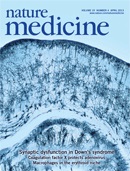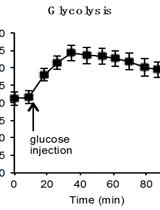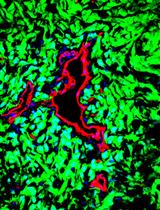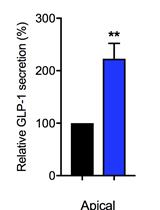- EN - English
- CN - 中文
ATP and Lactate Quantification
ATP 和乳酸盐含量的定量测定
发布: 2013年12月05日第3卷第23期 DOI: 10.21769/BioProtoc.986 浏览次数: 17263
评审: Anonymous reviewer(s)
Abstract
Cells use glucose to generate energy by two different metabolic processes: lactic fermentation and aerobic respiration. In the first common series of reactions, glucose is converted into pyruvate. In anaerobic conditions, pyruvate is transformed into lactate, this process yields to 2 ATP molecules per glucose molecule. In the presence of oxygen, pyruvate is imported into mitochondria where it is used in the Krebs (or TCA) cycle and oxydative phosphorylation. The global process of oxydative phosphorylation yields to 32 ATP per glucose molecule. For reasons not fully understood, in some pathological cases like cancer, cells use anaerobic glycolysis even in the presence of oxygen, in which case the process is called aerobic glycolysis (or Warburg effect). This results in an increased uptake of glucose and lactate production. Measure of intracellular ATP content and lactate concentrations can provide a readout of aerobic glycolyis.
Materials and Reagents
- For intracellular ATP content evaluation
- Murine Embrionic Fibroblasts (MEF)
- Dulbecco’s Modified Eagle’s Medium High glucose with L-glutamine (DMEM) (Gibco®, catalog number: 11965 )
- Foetal Calf Serum (FCS) (Gibco®, catalog number: 16010 )
- Penicillin/Streptamycin (Gibco®, catalog number: 15070 )
- Phosphate Buffered Saline (PBS) (EuroClone, catalog number: E0B4004L )
- Protein Dye Reagent Concentrate (Bio-Rad Laboratories, catalog number: 500-0006 )
- Bovine Serum Albumine (BSA) (Sigma-Aldrich, catalog number: A4503 )
- NaCl
- Na4HPO4/NaH2PO4
- Glycerol
- Triton X-100
- Complete protease inhibitors (Roche Diagnostics, catlalog number: 11697498001 )
- Phosphatase inhibitors (1 mM final concentration of glycerophosphate, sodium orthovanadate and sodium fluoride)
- Complete protease inhibitors (Roche Diagnostics)
- ATP détermination kit (Life Technologies, catalog number: A22066 )
- Lysis buffer (see Recipes)
- Standard Reaction Solution (see Recipes)
- Murine Embrionic Fibroblasts (MEF)
- For Lactate quantification
- MEF
- EnzyChromTM L-lactate Assay Kit (BioAssay Systems, catalog number: ECLC-100 )
- Dulbecco’s Modified Eagle’s Medium High glucose with stable L-glutamine (DMEM) (Gibco®, catalog number: 11965)
- Foetal Calf Serum (FCS) (Gibco®, catalog number: 16010 )
- Penicillin/Streptamycin (Gibco®, catalog number: 15070 )
- 0.4% Trypan Blue stain (Life Technologies, catalog number: T10282 )
- MEF
Equipment
- For intracellular ATP content evaluation
- For Lactate quantification
- 37 °C 5% CO2 Cell culture incubator
- 6 wells plates (Corning, Costar®, catalog number: CLS 3506)
- 96 wells plates (Corning, Costar®, catalog number: CLS 3596 )
- Countess automated cell counter with countess Cell Counting Chamber Slides (Life Technologies)
- Plate reader at 565 nm
- 37 °C 5% CO2 Cell culture incubator
Procedure
文章信息
版权信息
© 2013 The Authors; exclusive licensee Bio-protocol LLC.
如何引用
Rowe, I., Chiaravalli, M. and Boletta, A. (2013). ATP and Lactate Quantification. Bio-protocol 3(23): e986. DOI: 10.21769/BioProtoc.986.
分类
细胞生物学 > 细胞新陈代谢 > 糖类
生物化学 > 糖类 > 乳酸
细胞生物学 > 细胞信号传导 > 呼吸
您对这篇实验方法有问题吗?
在此处发布您的问题,我们将邀请本文作者来回答。同时,我们会将您的问题发布到Bio-protocol Exchange,以便寻求社区成员的帮助。
Share
Bluesky
X
Copy link















